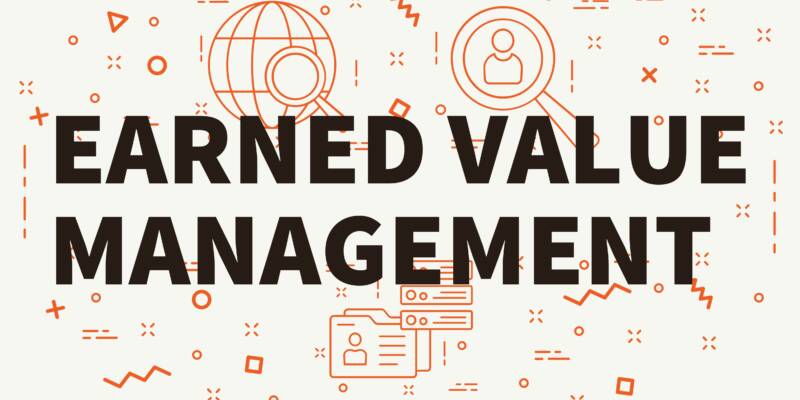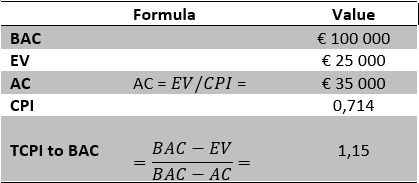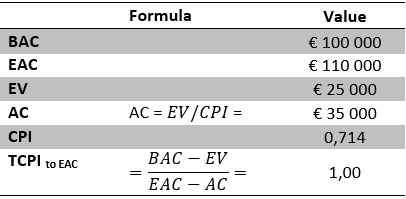
The "To Complete Performance Index"


How can we get the most out of our EVM metrics? We’ve evaluated our current cost and schedule performance, and have seen how to forecast the Estimate At Completion (EAC). Now is the time to evaluate the realism of our project’s Budget At Completion (BAC). Following the current conditions, is the aimed for budget still sufficient?
One of the most powerful (and underutilized) measures EVM grants us is the To Complete Performance Index. This is the Cost Performance Index (CPI) at which you must execute the remainder of the work to deliver the project within a certain budget. The budget aimed for has sometimes become idealistic. Comparing the TCPI with the current CPI gives a good insight on whether the foreseen budget or the EAC remain realistic. The difference between the cumulative CPI and the TCPI value should trigger the re-evaluation of the Estimate At Completion.
General formula
The general formula and understanding of this measure is the ratio between the remaining work and the remaining cost.

In comparison with the CPI, which is the ratio between the Earned Value (Budgeted Cost for Work Performed) and the Actual Cost of Work Performed.
There are two formulas provided by EVM. One can opt to calculate the TCPI to the Budget At Completion (BAC), which is contractually defined, or one can choose to perform towards its Estimate At Completion (EAC).


You’ll find a lot of statements in PMI that one is considered the formula suited for when you’re over budget, the other one for when you’re under budget. Both calculation methods are useful to calculate, independent of the current cost over- or underrun. We distantiate from the choice of TCPI method by current CPI. For example, it is perfectly possible to have a lower EAC than the BAC to use as your new goal and thus the CPI you'll need to maintain to reach said goal.
The TCPI to BAC formula will aim for the BAC agreed upon in the contract. We’ll call this the TCPIto BAC.
Evaluating the BAC’s realism
Let’s picture a € 100 000,00 project that’s performing at a SPI of 1,00 (this condition is chosen to exclude the schedule variance effect). At a certain moment in time, we’ve realized € 25 000,00 in Earned Value at an actual cost of € 35 000 and thus a CPI of 0,714. Let us calculate the TCPI we need to achieve to realize the remaining value at the price of the budget (TCPIto BAC).

Considering our project is performing at a 71,4 % cost efficiency rate (CPI = 0,714), we have to execute the remainder of the work at a 1,15 CPI to remain within budget. The difference between the past performance and the projected performance to remain within BAC is now deemed unrealistic. The Estimate at Completion (EAC) should be thoroughly re-evaluated. For US government projects, the threshold is 20 % difference between CPI and TCPI to EAC before re?evaluating.
Evaluating the EAC’s realism
When forecasting the budgets for the next year, the finance department re-evaluated the project’s budgets. Let’s picture the finance department proposing an EAC of € 110 000,00. They observed a € 10 000,00 overspending in the accounting system, which is not wrong, it’s the actual Cost Variance (since the project’s SPI = 1,00). We can evaluate the realism of this estimate by calculating which CPI we need to maintain to reach the newly set goal (by the finance department).

The TCPIto EAC value of 1,00 states that if we execute the remainder of the project at the budgeted cost, we reach our Estimate at Completion of € 110 000. Since the Project Manager is close to the project, and knows what is going on, he/she will be able to confirm/neglect the feasibility of the newly calculated EAC. If, for example, the €10 000 cost overrun was a one-time event, the newly estimated budget could be sufficient. If the €10 000 overrun is due to continuous bas performance, extrapolation techniques, from our forecast the Estimate At Completion (EAC), can be used.
In this example, using the CPI to extrapolate current performance, the (independent) EAC would be € 140 000.
Conclusion
When analyzing your project’s performance, and projecting it to the future, EVM grants a handful of measures. These measures trigger further investigation on the project’s health and hand you a platform of discussion. The correct usage of these measures opens a wide range of evaluation methods that deliver deeper insight in your project’s schedule and cost performance. Often, projects implement only the tip of the EVM iceberg and call it an EVMS. Primaned can guide your enterprise to implement a fully operational EVMS, containing all Earned Value Management has to offer to deliver you the insights you need. This ensures the fast call-to-action you need to deliver your projects with maximal value.
Leave your experiences or remarks in the comments section below. We’re happy to share our vision and experiences with you.
This blog is part of our Earned Value Series:

